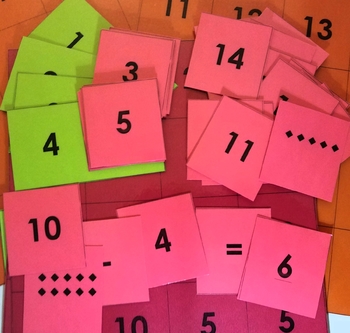Eureka Math Grade 1 Five Group, Hide Zero, & Expression Cards Template
Mr Bs Store
15 Followers
Grade Levels
K - 2nd
Subjects
Resource Type
Standards
CCSS1.NBT.C.4
CCSS1.OA.A.1
CCSS1.OA.A.2
CCSS1.OA.C.6
Formats Included
- PDF
Pages
5 pages
Mr Bs Store
15 Followers
What educators are saying
Thank you so much!! This was perfect for our lesson. I was able to print and laminate them and use them over and over.
These are just what I needed to go with Eureka math lessons so each of my students can have their own set. Thank you!
Description
I designed these cards to align when printing. I was getting frustrated with the templates that didn't line up when copied or printed, so I made some that do. Print number side, then turn paper over, and then print 5-group side.
I re-created the Eureka template using little diamonds instead of dots for the 5 Group cards (1-10), and used that same template for the Hide Zero cards (10, 20, 30, and 40). I also included one-sided cards for numbers 11-20, +, -, =, and expression cards.
These are designed to be clear, not use a lot of ink or paper, and be easy to cut out.
Total Pages
5 pages
Answer Key
N/A
Teaching Duration
N/A
Report this resource to TPT
Reported resources will be reviewed by our team. Report this resource to let us know if this resource violates TPT’s content guidelines.
Standards
to see state-specific standards (only available in the US).
CCSS1.NBT.C.4
Add within 100, including adding a two-digit number and a one-digit number, and adding a two-digit number and a multiple of 10, using concrete models or drawings and strategies based on place value, properties of operations, and/or the relationship between addition and subtraction; relate the strategy to a written method and explain the reasoning used. Understand that in adding two-digit numbers, one adds tens and tens, ones and ones; and sometimes it is necessary to compose a ten.
CCSS1.OA.A.1
Use addition and subtraction within 20 to solve word problems involving situations of adding to, taking from, putting together, taking apart, and comparing, with unknowns in all positions, e.g., by using objects, drawings, and equations with a symbol for the unknown number to represent the problem.
CCSS1.OA.A.2
Solve word problems that call for addition of three whole numbers whose sum is less than or equal to 20, e.g., by using objects, drawings, and equations with a symbol for the unknown number to represent the problem.
CCSS1.OA.C.6
Add and subtract within 20, demonstrating fluency for addition and subtraction within 10. Use strategies such as counting on; making ten (e.g., 8 + 6 = 8 + 2 + 4 = 10 + 4 = 14); decomposing a number leading to a ten (e.g., 13 - 4 = 13 - 3 - 1 = 10 - 1 = 9); using the relationship between addition and subtraction (e.g., knowing that 8 + 4 = 12, one knows 12 - 8 = 4); and creating equivalent but easier or known sums (e.g., adding 6 + 7 by creating the known equivalent 6 + 6 + 1 = 12 + 1 = 13).


